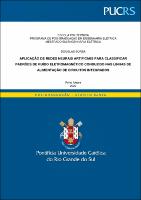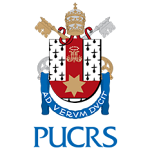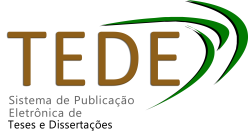| Share record |


|
Please use this identifier to cite or link to this item:
https://tede2.pucrs.br/tede2/handle/tede/10166| Document type: | Dissertação |
| Title: | Aplicação de redes neurais artificiais para classificar padrões de ruído eletromagnético conduzido nas linhas de alimentação de circuitos integrados |
| Author: | Borba, Douglas  |
| Advisor: | Vargas, Fabian Luis |
| Abstract (native): | Com o crescente uso de sistemas embarcados em nosso dia a dia e o aumento do nível de ruído eletromagnético no ambiente em que esses sistemas estão expostos, a necessidade de uma operação confiável é primordial. Quando os componentes vitais desses sistemas ficam expostos a uma grande quantidade de ruídos, que podem ser tanto conduzidos como radiados, esses ruídos podem acarretar em falhas graves e incontornáveis, por isso torna-se imprescindível a análise e testes confiáveis em cima destes componentes. Nesse cenário, este trabalho apresenta um estudo sobre o uso de técnicas de aprendizado de máquina (redes neurais artificiais) para realizar a identificação e classificação em campo de diferentes tipos de ruído eletromagnético conduzido nas linhas de alimentação de circuito integrados (CIs), de acordo com um conjunto específico das normas IEC. Este trabalho detalha o desenvolvimento de uma metologia o qual as formas de onda dos fenômenos contidos nas normas são simuladas através de software devido ao tempo disposto para um trabalho de mestrado acrescido do viés de pandemia e a dificuldade de acesso aos laboratórios por conta deste cenário, e também pelo risco envolvendo o tempo e complexidade para obtenção dessas formas de onda em hardware utilizando um microprocessador, por exemplo. Resultados experimentais obtidos nesta metodologia, sugerem que a abordagem proposta é muito eficaz para atingir o objetivo de identificar os tipos de ruídos eletromagnéticos conduzidos. Dessa forma, a metodologia desenvolvida possibilita a inserção da inteligência artificial no contexto de testes, permitindo aos desenvolvedores de sistemas e circuitos integrados uma nova abordagem para avaliar a susceptibilidade à EMI conduzido, possibilitando o desenvolvimento de novas técnicas para o aumento da confiabilidade e robustez dos projetos. |
| Abstract (english): | With the increasing use of embedded systems in our daily lives and the increasing level of electromagnetic noise in the environment in which these systems are exposed, the need for reliable operation is paramount. When the vital components of these systems are exposed to a large amount of noise, which can be both conducted and radiated, these noises can lead to serious and unavoidable failures, so it is essential to analyze and reliably test these components. In this scenario, this work presents a study on the use of machine learning techniques (artificial neural networks) to carry out the identification and classification in the field of different types of electromagnetic noise conducted in the power lines of integrated circuits (ICs), according to with a specific set of IEC standards. This work details the development of a methodology in which the waveforms of the phenomena contained in the standards are simulated through software due to the time available for a master's work plus the pandemic bias and the difficulty of accessing the laboratories due to this scenario, and also by the risk involving the time and complexity to obtain these waveforms in hardware using a microprocessor, for example. Experimental results obtained in this methodology suggest that the proposed approach is very effective to achieve the objective of identifying the types of electromagnetic noise conducted. In this way, the methodology developed allows the insertion of artificial intelligence in the context of tests, allowing the developers of systems and integrated circuits a new approach to assess the susceptibility to conducted EMI, enabling the development of new techniques to increase the reliability and robustness of the projects. |
| Keywords: | Ruído Conduzido Interferência Eletromagnética Rede Neural Artificial Sistema Embarcado Robusto Anaconda Navigator Tensor Flow Conducted Noise Electromagnetic Interference Machine Learning Deep Neural Network Robust Embedded System Anaconda Navigator Tensor Flow |
| CNPQ Knowledge Areas: | ENGENHARIAS |
| Language: | por |
| Country: | Brasil |
| Publisher: | Pontifícia Universidade Católica do Rio Grande do Sul |
| Institution Acronym: | PUCRS |
| Department: | Escola Politécnica |
| Program: | Programa de Pós-Graduação em Engenharia Elétrica |
| Access type: | Acesso Aberto |
| Fulltext access restriction: | Trabalho não apresenta restrição para publicação |
| URI: | https://tede2.pucrs.br/tede2/handle/tede/10166 |
| Issue Date: | 31-Jan-2022 |
| Appears in Collections: | Programa de Pós-Graduação em Engenharia Elétrica |
Files in This Item:
| File | Description | Size | Format | |
|---|---|---|---|---|
| DOUGLAS_BORBA_DIS.pdf | DOUGLAS_BORBA_DIS | 2.13 MB | Adobe PDF |  Download/Open Preview |
Items in DSpace are protected by copyright, with all rights reserved, unless otherwise indicated.




